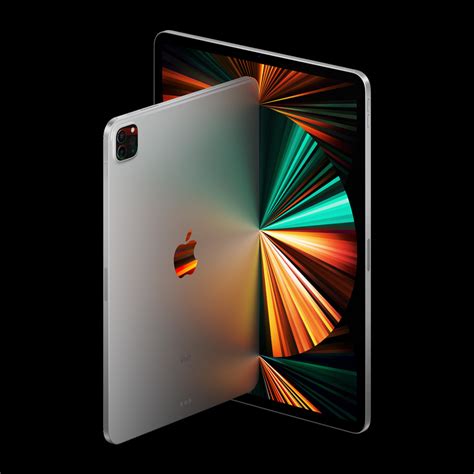What is Apple iPad M1 Pro?

The Apple iPad Pro is a high-end tablet computer from Apple Inc. that features the company's latest M1 chip. This chip boasts impressive performance feats, such as eight-core CPU and GPU performance, advanced neural engine capabilities, and fast machine learning processing.
The iPad Pro is available in two sizes: 11-inch and 12.9-inch, both of which feature Liquid Retina XDR displays that offer high dynamic range and impressive color accuracy. The device also comes with a front-facing camera with Center Stage, which automatically follows and pans during video calls to keep the user in the center of the action.
The iPad Pro is designed for use with a range of Apple accessories, such as the Magic Keyboard, Apple Pencil, and Smart Folio. This makes it a versatile tool for a range of users, from creatives who want to sketch and illustrate to business professionals who need a reliable, portable computing device for on-the-go work.
Overall, the Apple iPad Pro with M1 chip is an impressive and versatile device that is suited to a range of tasks, from multimedia consumption to productivity work. With its advanced hardware and software, it's no wonder that the iPad Pro is a top choice for many users who want the best tablet experience.
Frequently Asked Questions about apple ipad m1 pro
The latest iPad Air retains the iPad Pro-esque redesign of the 2020 model but does away with the A14 Bionic processor in favor of Apple's fast M1 chip. It also comes in one of five colors and boasts a 12MP front-facing camera with support for Apple's Center Stage feature.
Its laptop-class M1 chip allows the Air to work equally well as a workstation and a casual browsing device, and it can easily last a day on a single charge (or more) in either scenario.
Eyes right off the bat. And that's the new liquid retina xdr display. This feature is only available on the 12.9 inch model and we did an entire video comparing both displays. From each ipad.
The iPad Pro's M1 chip means it has the same chip as Apple's laptop line-up. At its most basic level, that means that it's the most capable, powerful tablet around.
Apple M1 is a series of ARM-based systems-on-a-chip (SoCs) designed by Apple Inc. as a central processing unit (CPU) and graphics processing unit (GPU) for its Mac desktops and notebooks, and the iPad Pro and iPad Air tablets.
Apple uses memory, which is designed to serve both large chunks of data and do it very quickly. It is called 'low latency and high throughput'. This removes the need to have two different types of memory and all the copying of data between them, making the M1 faster.
Apple uses memory, which is designed to serve both large chunks of data and do it very quickly. It is called 'low latency and high throughput'. This removes the need to have two different types of memory and all the copying of data between them, making the M1 faster.
The M1 processor is still very speedy, even now in 2023, and should easily last over five years (or more), as Apple has a good track record for offering software support. If you're picking up a 2021 iPad Pro, you're getting a high-refresh-rate screen, Face ID, a USB-C port, and overall excellent performance.
The M2 is a powerful chip, with eight CPU cores divided into four performance cores and four efficiency cores. In our testing, the M2 is roughly 15 percent faster than the M1. The M2 chip in the iPad Pro also has 10 GPU cores, an increase over the 8 GPU cores in the M1.
Not only does the iPad Pro offer the largest screen size in its 12.9-inch model but it also features the best resolution (2732 x 2048 at that size) and Apple's ProMotion technology, which boosts the display's refresh rate to provide much smoother movement when needed, or battery-saving lower refresh rates when the ...
Limited Software Compatibility: One notable drawback of the M1 chip is its limited software compatibility with legacy applications designed for Intel-based Macs.
The M1 was the first personal computer chip built using cutting-edge 5-nanometer process technology. It packs in 16 billion transistors and has an 8-core GPU. Compared to the Intel Macs, M1 delivers up to 3.5 times faster CPU performance, up to 6 times faster GPU performance, and up to 15 times faster machine learning.
The M1, for example, was available in a seven-core or eight-core GPU configuration. The M1 Pro has 14-core and 16-core GPU options, while the M1 Max has 24-core and 32-core variants. With the M1 Ultra, Apple has again doubled the graphical core count.
The M1 contains dedicated neural network hardware in a 16-core Neural Engine, capable of executing 11 trillion operations per second. Other components include an image signal processor, a PCIe storage controller, a USB4 controller that includes Thunderbolt 3 support, and a Secure Enclave.
The 8-core CPU has six high performance cores and two high efficiency cores. M1 Pro chips used in all other 14 and 16-inch MacBook Pro models have 10 cores. According to Apple, the M1 Pro's 10-core CPU is up to 70 percent faster than the 8-core CPU in the original M1 chip.
Intel vs M1: Battery life
For example, the Intel Mac had only 25% battery life remaining, while the M1 still had 72%. This perfectly sums up the spirit of the M1: High power with increased energy efficiency! Also read to know more on the differences between the M1 Chip vs M1 Pro vs M1 Max, here.
































